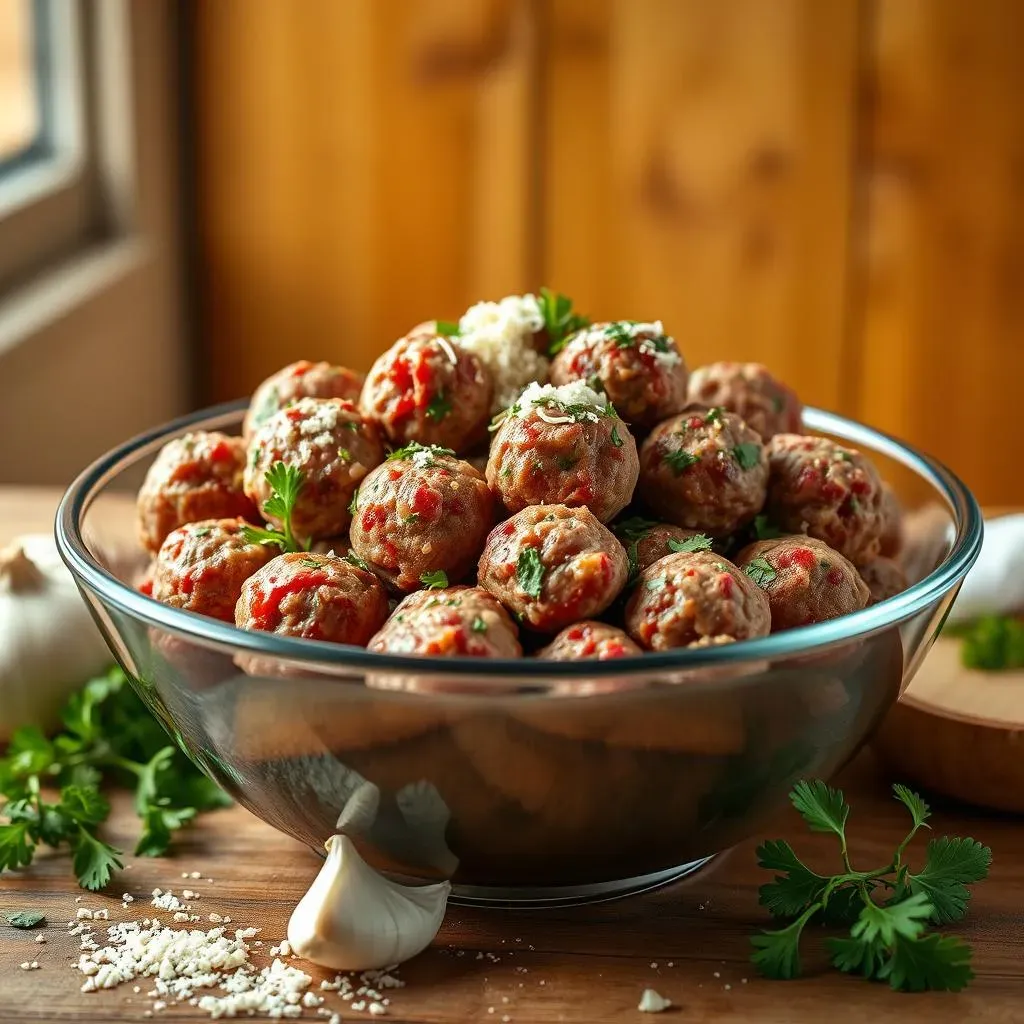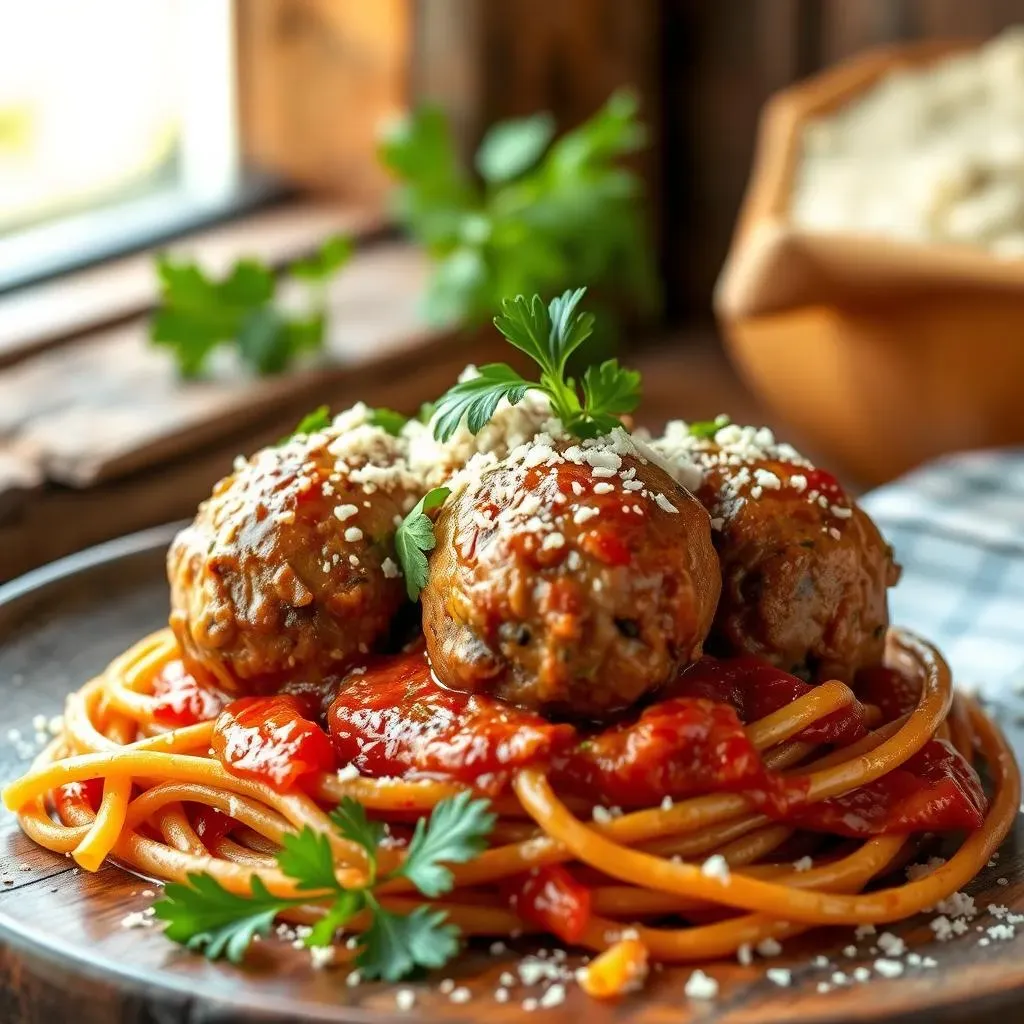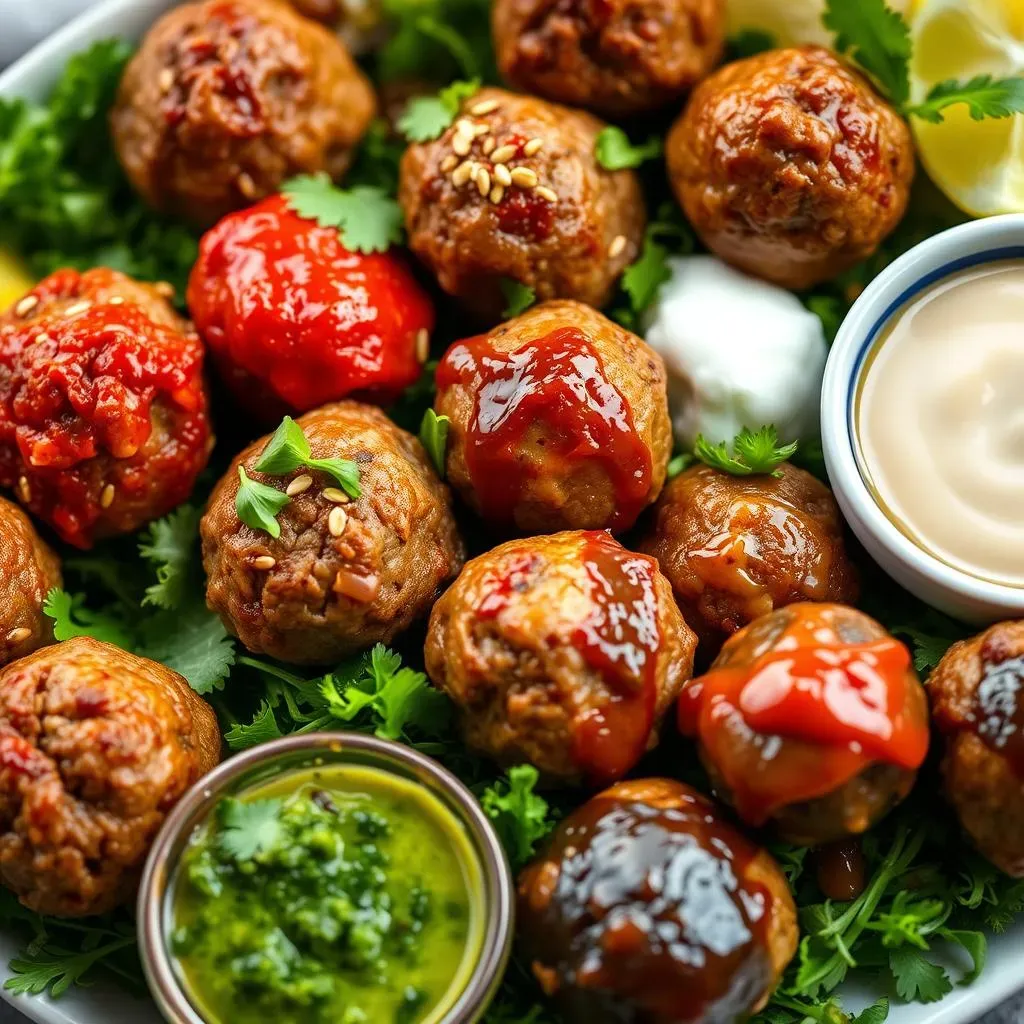Table of Contents
Are you ready to elevate your meatball game? Forget bland, dry meatballs – we're diving headfirst into the world of succulent, flavor-packed perfection with the ultimate "meatball recipe pork veal beef." This isn't just any recipe; it's a culinary journey, a harmonious blend of textures and tastes that will transform your dinner table. We'll explore the art of crafting the ideal meatball, starting with the perfect meat combination: the rich depth of beef, the subtle sweetness of pork, and the tender delicacy of veal. We'll uncover the secrets to achieving that melt-in-your-mouth texture, the perfect seasoning balance, and the best cooking techniques to ensure juicy, flavorful results every single time. Get ready to learn how to create meatballs that are so good, they'll disappear faster than you can say "Sunday gravy." This comprehensive guide will take you from beginner to meatball maestro, covering everything from ingredient selection and preparation to cooking methods and delicious serving suggestions. Prepare to be amazed!
Mastering the Meatball Recipe: Pork, Veal, and Beef

Mastering the Meatball Recipe: Pork, Veal, and Beef
The Holy Trinity of Meat
So, you're ready to make some seriously amazing meatballs? Fantastic! The key to truly outstanding meatballs lies in understanding the magic of the three-meat blend: pork, veal, and beef. Each meat contributes something unique. Beef brings a rich, savory depth; pork adds incredible juiciness and a touch of sweetness; and veal provides a delicate tenderness that elevates the whole experience. Think of it as a culinary orchestra, where each instrument (meat) plays a vital role in creating a symphony of flavor. Don't be afraid to experiment with different ratios. A classic starting point is equal parts of each, but you can adjust to your preference. For example, if you prefer a richer, more intense flavor, you might increase the proportion of beef. If you’re looking for extra moisture, lean more toward the pork. It’s all about finding your perfect balance.
Remember, the quality of your ingredients directly impacts the final result. Opt for freshly ground meats whenever possible. Avoid pre-ground mixes found in some supermarkets; these often contain added fillers and preservatives that can negatively affect both the taste and texture. If you have a local butcher, even better! They can often grind the meat to your specifications, ensuring the perfect consistency for your meatballs. And don't forget the fat content – a little fat is your friend here! It's what keeps the meatballs incredibly juicy and prevents them from becoming dry and tough. Check out our guide on buying ground beef for meatballs for more tips!
Meat | Flavor Contribution | Texture Contribution |
|---|---|---|
Beef | Savory, Rich | Firm, Hearty |
Pork | Sweet, Juicy | Tender, Moist |
Veal | Delicate, Mild | Tender, Fine |
Beyond the Meat: Essential Ingredients
While the meat is the star of the show, several other ingredients play crucial supporting roles. Don't underestimate the power of fresh herbs like parsley and oregano – they add a burst of aromatic freshness that complements the richness of the meat. Garlic, of course, is a must-have; it adds a pungent depth that elevates the entire flavor profile. Freshly grated Parmesan cheese is another key element; it adds a salty, umami richness that ties everything together. Finally, there's the breadcrumb binder. While you can use store-bought breadcrumbs, making your own from stale bread adds a unique texture and flavor that's hard to beat. See our recipe for easy beef meatballs for more ideas.
The amount of liquid you add to the mixture is also critical. Too much, and your meatballs will fall apart; too little, and they'll be dry. Start with a small amount of milk or water, and gradually add more until you reach the desired consistency – the mixture should be moist but still hold its shape. If you're unsure, start with less and add more as needed. It's always easier to add more liquid than to take it away! Many cooks find that using milk instead of water adds a subtle creaminess that enhances the flavor and texture. For a simple and delicious recipe try our Italian meatball recipe with ground beef.
- Fresh Parsley
- Oregano
- Freshly Grated Parmesan
- Homemade Breadcrumbs
- Milk or Water (for binding)
The Perfect Meatball Recipe: A Blend of Pork, Veal, and Beef

The Perfect Meatball Recipe: A Blend of Pork, Veal, and Beef
Mixing Your Meats: The Art of the Blend
Now, let's talk about actually *making* those amazing meatballs. Remember that beautiful blend of pork, veal, and beef we discussed? It's time to bring it to life! The key here isn't just throwing the meats together; it's about a gentle, careful incorporation. You want to avoid overmixing, which can lead to tough meatballs. Think of it like this: you're not trying to create a meat paste, but rather a loose, slightly textured mixture that holds its shape beautifully. Use your hands—yes, get in there!—to gently combine the meats, ensuring an even distribution. This hands-on approach allows you to feel the texture and adjust the consistency as you go. For a truly authentic experience, try our beef and pork meatballs recipe for a simpler approach.
Once the meats are combined, it’s time for the supporting cast: herbs, spices, cheese, and the crucial binder (usually breadcrumbs and milk or water). Again, gentle is the name of the game. You don't want to pulverize the mixture; you want to create a harmonious blend where each ingredient contributes its unique flavor and texture. Once everything is incorporated, let the mixture rest for at least 15 minutes in the refrigerator. This allows the flavors to meld and the mixture to firm up slightly—making it easier to roll into perfect, evenly sized meatballs.
- Gently combine meats.
- Avoid overmixing.
- Add other ingredients carefully.
- Refrigerate for at least 15 minutes.
Shaping and Sizing: The Meatball Makeover
Now for the fun part: shaping your meatballs! Consistency is key here. Aim for uniformly sized meatballs, not only for even cooking but also for visual appeal. Using a small ice cream scoop or a meatball-forming tool can help you achieve that perfect, consistent size. This is crucial for even cooking, ensuring that each meatball reaches the ideal internal temperature without overcooking the outside. If you’re aiming for a rustic look, feel free to roll them by hand, just be mindful of maintaining a consistent size as much as possible. For some extra inspiration, check out our guide on Italian meatballs with ground beef.
Once your meatballs are shaped, you have a few options for cooking. You can pan-fry them in olive oil until golden brown, bake them in the oven for a healthier approach, or simmer them gently in your favorite sauce. Each method yields a slightly different texture and flavor profile. Pan-frying creates a delicious crispy exterior, while baking results in a softer, more tender meatball. Simmering in sauce allows the meatballs to absorb the flavors of the sauce, creating a truly unforgettable dish. Consider trying our gluten-free beef meatballs for a healthy twist.
Cooking Method | Texture | Flavor Profile |
|---|---|---|
Pan-frying | Crispy exterior, juicy interior | Rich, savory |
Baking | Soft, tender | Subtle, delicate |
Simmering | Tender, flavorful | Infused with sauce flavors |
The Finishing Touches: Sauce and Serving
Your meatballs are almost ready for their close-up! But before we get there, let's talk sauce. A great meatball deserves a great sauce, and the possibilities are endless. Classic marinara is always a winner, but don't be afraid to experiment. A creamy tomato sauce, a vibrant pesto, or even a spicy arrabbiata can all elevate your meatballs to new heights. The sauce not only adds flavor but also helps keep the meatballs moist and tender during cooking. For a simple yet elegant sauce, try our beef meatball sauce recipe.
Finally, it's time to serve your masterpiece! Classic spaghetti and meatballs is a timeless combination, but the possibilities are endless. Serve your meatballs over creamy polenta, in a hearty stew, nestled in a crusty sub roll, or even as part of a vibrant salad. The key is to let your creativity shine and find the perfect pairing for your delicious, homemade meatballs. No matter how you choose to serve them, your guests will be impressed by your culinary skills. And don't forget the sides! A simple salad or some crusty bread can perfectly complement your meatball creation. Explore our collection of meatball recipes with ground beef for more ideas!
- Choose your favorite sauce.
- Serve over pasta, polenta, or in a sub.
- Get creative with your sides!
Beyond the Basics: Variations on the Classic Meatball Recipe (Pork, Veal, Beef)

Beyond the Basics: Variations on the Classic Meatball Recipe (Pork, Veal, Beef)
Spice It Up: Global Flavor Adventures
Let's break free from tradition! While the classic pork, veal, and beef combo is undeniably delicious, the world of meatballs is vast and exciting. Why stick to Italian flavors when you can explore the globe? Think fiery harissa meatballs with a North African flair, fragrant Thai meatballs infused with lemongrass and ginger, or even spicy Korean meatballs with a gochujang kick. The possibilities are endless! The key is to select spices and aromatics that complement the richness of the meat without overpowering it. For example, the earthy warmth of cumin and coriander would pair beautifully with the richness of the meat, adding a wonderful complexity. Don't be afraid to experiment – let your culinary creativity run wild! For some inspiration, try our Italian sausage and ground beef meatballs recipe for a taste of something different.
Consider incorporating different types of cheese. Instead of just Parmesan, try adding crumbled feta for a tangy twist, or a sharp cheddar for a bolder flavor. You could even incorporate some creamy goat cheese for a unique, luxurious touch. Remember, the goal is to create a balanced flavor profile, where each element complements the others without overpowering the overall taste. Using a variety of cheeses adds layers of flavor and texture, making your meatballs even more irresistible. Check out our best beef meatball recipe for more ideas on incorporating different cheeses.
- Harissa Meatballs
- Thai Meatballs
- Korean Meatballs
Meat Alternatives: Vegetarian and Beyond
Who says meatballs have to be meaty? The beauty of meatballs lies in their versatility. You can easily adapt this recipe to include vegetarian or vegan alternatives. For a vegetarian option, consider using a hearty mixture of lentils, mushrooms, and vegetables, bound together with breadcrumbs and herbs. This provides a satisfyingly dense and flavorful meatball that stands up well to any sauce. For vegan meatballs, you could use a combination of beans, vegetables, and plant-based protein such as tofu or tempeh. Remember to choose a binder that works well with your chosen ingredients, such as breadcrumbs, oats, or mashed potatoes. For a delicious meatless option, try our Beyond Beef Meatball recipe.
Experiment with different grains and legumes! Quinoa, farro, or even barley can be added to your meatball mixture for added texture and nutritional value. Similarly, incorporating beans such as chickpeas or black beans can add a wonderful depth of flavor and increase the protein content. Remember to adjust the liquid accordingly, as different grains and legumes absorb moisture at different rates. Don't be afraid to get creative and try out different combinations until you find your perfect meatless meatball. For a simple and flavorful option, check out our gluten-free beef meatballs recipe, which can be easily adapted for vegetarian or vegan diets.
Meatball Type | Main Ingredients | Binder |
|---|---|---|
Vegetarian | Lentils, mushrooms, vegetables | Breadcrumbs |
Vegan | Beans, vegetables, tofu/tempeh | Breadcrumbs, oats |
Size and Shape Matters: Beyond the Classic Round
Think outside the meatball! While classic round meatballs are always a winner, don’t be afraid to experiment with size and shape. Mini meatballs are perfect for appetizers or as part of a larger dish, while larger meatballs make a satisfying main course. You can even try forming your meatball mixture into flat patties, similar to hamburgers or sliders. This offers a different textural experience, and it can be particularly useful if you're short on time or looking for a quick and easy meal. For a unique take on meatballs, try our Beef Meatball Subs recipe.
Consider using different cooking techniques. Instead of just pan-frying, baking, or simmering, try grilling your meatballs for a smoky char. You can also try deep-frying them for an extra crispy exterior, or even air-frying them for a healthier option. Each cooking method will yield a slightly different flavor profile and texture, allowing you to experiment and find your preferred method. Remember to adjust cooking times accordingly, as different sizes and shapes will require different cooking times to ensure that the meatballs are cooked through. For a quick and easy meal, try our Quick Beef Meatball recipe.
- Mini Meatballs
- Meatball Patties
- Grilled Meatballs
- Deep-fried Meatballs
- Air-fried Meatballs